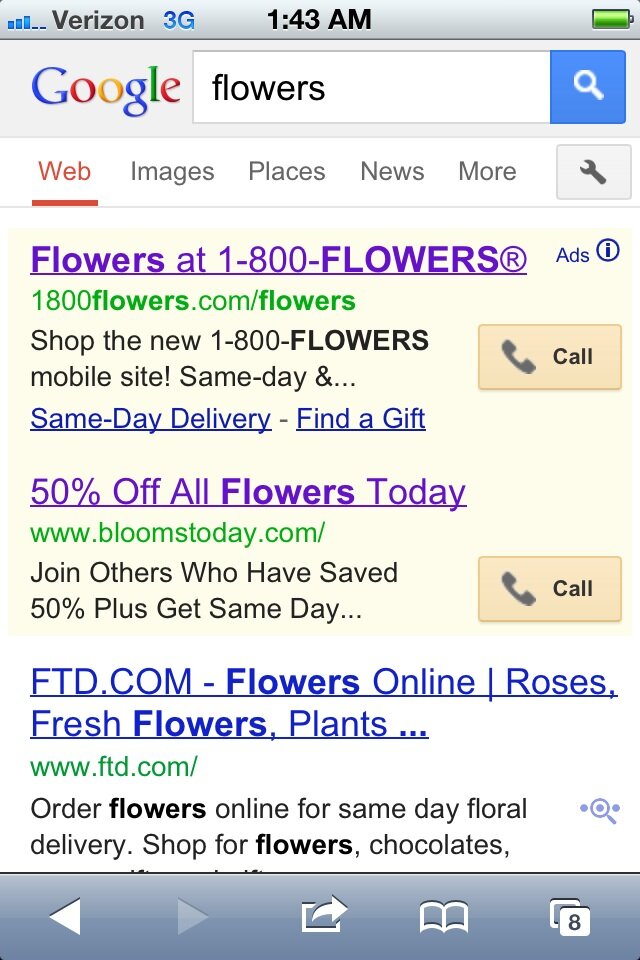Webinar recap: mobile’s influence on search marketing
November 2, 2012 Leave a Comment
Tuesday’s webinar on search engine marketing was full of useful strategic advice for helping merchants maximize their investments, both for optimizing to boost natural search results rankings and for paid search advertising. One key takeaway: both types of search marketing have been revolutionized by the advent of mobile.
When it comes to natural SEO, search engines are increasingly allocating real estate on the first page of results to local listings tied to mapping services — a shift that caters to mobile shoppers on the go. Fully 94% of smartphone owners have looked for local information, according to Google – and more than , according to The Pew Internet & American Life Project
And paid search ads are receiving more and more traffic from mobile devices. The share of clicks to search ads grew 132% in the course of 2011 alone, and is estimated to total 25% of all clicks by the end of this year, according to Marin Software.

To adapt search marketing strategies to accommodate the growing importance of mobile, merchants should:
Enhance on-site store locator information with a unique page for each outlet, and optimize off-site listings to match. As discussed in a prior post, most local directories offer the opportunity for business owners to “claim” their pages and add information such as store hours and the types of products and services offered. In addition to local listings tied to search engines, merchants should be sure to optimize their information on other business directory sites, such as CitySearch, Yellow Pages, and SuperPages, as well as review sites like Yelp!.
A search for outdoor retailer REI produces a series of local results in the second position in organic search results. The Google Plus Local page includes store-specific information, such as specialty services offered, and links directly to a page on the main REI site specific to that location, which lists still more localized information, such as a schedule of in-store events and classes.


Target mobile phone search ads by region. Mobile paid search remains cost-effective, with costs per click lower than on desktop browsers: in 2011, the average cost per click for desktop search was $0.83, while on smartphones it was $0.53 and on tablets it was $0.63, according to Marin Software. Merchants should capitalize on this cost-effectiveness by crafting separate mobile campaigns, which perform 11.5% better than mobile-desktop hybrid campaigns, according to Google. Not only should the ad copy be mobile-specific; it should also take into account local physical locations and offer. Merchants should also consider enhancements such as click-to-call and integrated location mapping to further enable shoppers on the go. Such enhancements have the added benefit of giving merchants more real estate on small mobile phone screens, increasing the likelihood for top bidders to dominate the page.
Banana Republic tailors its mobile search ad to include click-to-call functionality as well as a link for directions. Additionally, whereas the desktop ad puts the emphasis on a free shipping offer likely to appeal only to online shoppers, the mobile ad mentions a general $35 discount available in stores as well as online.

Devise mobile-friendly landing pages. Paid and natural search links alike should point shoppers to pages that fit the format of the intended device. Not only do optimized landing pages serve users better, leading to more engagement and conversions, but Google also factors landing page usability into its algorithm for serving mobile ads, favoring those listings that link to mobile-optimized content. Merchants should:
- Tailor technology. Eliminate elements that use incompatible technology, such as Flash, or that may not render well on touchscreens, such as Javascript flyouts or popups.
- Streamline content. On small screens, the connection between the link text and the landing page should be more clear than ever, and the call to action should be prominent.
1-800-Flowers calls out its gift finder as a sitelink in its mobile search ad, which highlights that the brand has a mobile-friendly site. Shoppers who click the “Find a Gift” link can use a streamlined form to specify the delivery region , occasion and date – thereby fulfilling the ad’s promise of mobile ease-of-use – or browse gift products with the ability to sort by a number of criteria. The label “find a gift fast” underscores the speed and simplicity of the process.


The webinar covered many more aspects of search marketing, from social media’s impact on SEO to retargeting campaigns — so download the replay or the related whitepaper today. And tell us: what are your top search marketing priorities?
Connect with us: